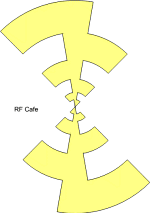 All RF Cafe Quizzes make great fodder for
employment interviews for technicians or engineers - particularly those who are
fresh out of school or are relatively new to the work world. Come to think of it,
they would make equally excellent study material for the same persons who are going
to be interviewed for a job. Bonne chance, Viel Glück, がんばろう,
buena suerte, удачи, in bocca al lupo, 행운을 빕니다,
ádh mór, בהצלחה, lykke til, 祝你好運.
Well, you know what I mean: Good luck! All RF Cafe Quizzes make great fodder for
employment interviews for technicians or engineers - particularly those who are
fresh out of school or are relatively new to the work world. Come to think of it,
they would make equally excellent study material for the same persons who are going
to be interviewed for a job. Bonne chance, Viel Glück, がんばろう,
buena suerte, удачи, in bocca al lupo, 행운을 빕니다,
ádh mór, בהצלחה, lykke til, 祝你好運.
Well, you know what I mean: Good luck!
Click here for the complete list of
RF Cafe Quizzes.
Note: Some material based on books have quoted passages.
Return to RF Cafe Quiz #53
 This
quiz is based on the information presented in Chipless RFID Reader Architecture, by Nemai Chandra Karmakar,
Randika V. Koswatta, Prasanna Kalansuriya, and Rubayet E-Azim. Graciously provided by
Artech House. This
quiz is based on the information presented in Chipless RFID Reader Architecture, by Nemai Chandra Karmakar,
Randika V. Koswatta, Prasanna Kalansuriya, and Rubayet E-Azim. Graciously provided by
Artech House.
Note: Some of these books are available as prizes in the monthly
RF Cafe Giveaway.
1. What is a major advantage of chipless RFID over existing RFID? b) Lower
cost Chipless RFID must be produced in the sub-cent range in order to provide low-cost, item-level tagging
that is competitive with UPC scans. (see page 2) 2. What is a name
given to fully printable, passive microwave and millimeter-wave chipless RFID tags? b) Radar arrays
RFID works on a radar type principle where an interrogation signal is broadcast and then the receiver listens for
an echo with detectable data. (see page 15) 3. What is the assigned
frequency (or band) on (within) which RFID systems must operate? d) There is no specific assigned frequency
/ band See paper by
Enigmatics and
Impinj
(FCC website) 4. What type(s) of frequency domain based RFID tags are
currently in use? d) All the above Many types of schemes are use, but the chemical tag is the most
interesting (to me) in that it uses many different compounds that resonate at discrete frequencies to reply with
unique identification codes. (see page 20) 5. What is the common
name given to the device that performs the interrogation of an RFID system? a) A reader 'Reader'
is the common name, and 'interrogator' is the technical nomenclature. (see page 43)
6. What is / are the current limitation(s) of chipless RFID readers? d) All
the above Because the entire onus of signal quality and processing is placed on the reader. In addition to the
three issues there are also anti-collision, error correction, and tag orientation limitations. (see page 60)
7. What is a rectenna? c) A rectifying antenna that converts
a microwave signal into DC power (see page 284)

8. What type of antenna is shown to the right? c) Circular log periodic
(see page 177) 9. What is the most basic antenna that can yield omnidirectional
radiation patterns over a UWB (ultra wide bandwidth) band? a) Disk-loaded monopole A disk-loaded
monopole is the most basic antenna that can yield omnidirectional radiation patterns and a uniform return loss over
the UWB band. (see page 200) 10. How can smart antenna technology
mitigate the interference problem of RFID reading? b) With electronic beam steering A smart antenna
can solve the interference problem by electronically controlling the main beam emitted from the reader's antenna
toward the desired tags and nulls toward the interfering signal. (see page 150)
Posted September 25, 2013
|











